Perm
Perm (Russian: Пермь, IPA: [pʲɛrmʲ];[13]) is a city and the administrative centre of Perm Krai. It is located on the banks of the Kama River in Western Russia, near the Ural Mountains.
Perm Пермь | |
|---|---|
City[1] | |
 View of Perm | |
 Flag 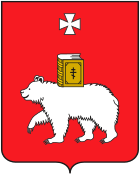 Coat of arms | |
Location of Perm 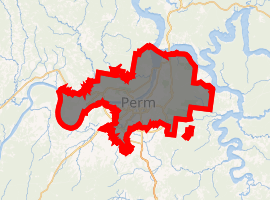
| |
.svg.png) Perm Location of Perm  Perm Perm (Europe) | |
| Coordinates: 58°00′N 56°19′E | |
| Country | Russia |
| Federal subject | Perm Krai[1] |
| Founded | May 15, 1723 |
| City status since | October 29, 1781 |
| Government | |
| • Body | City Duma[2] |
| • Mayor[3] | Dmitry Samoilov[3] |
| Area | |
| • Total | 799.68 km2 (308.76 sq mi) |
| Elevation | 171 m (561 ft) |
| Population | |
| • Total | 991,162 |
| • Estimate (2018)[7] | 1,051,583 (+6.1%) |
| • Rank | 13th in 2010 |
| • Density | 1,200/km2 (3,200/sq mi) |
| • Subordinated to | city of krai significance of Perm[1] |
| • Capital of | Perm Krai[1], Permsky District[1] |
| • Urban okrug | Perm Urban Okrug[8] |
| • Capital of | Perm Urban Okrug[8], Permsky Municipal District[9] |
| Time zone | UTC+5 (MSK+2 |
| Postal code(s)[11] | 614xxx |
| Dialing code(s) | +7 342[12] |
| OKTMO ID | 57701000001 |
| City Day | June 12 |
| Website | www |
According to the 2010 Census, Perm's population is 991,162,[6] down from 1,001,653 recorded in the 2002 Census[14] and 1,090,944 recorded in 1989 Census.[15] As of the 2010 Census, the city was the thirteenth most populous in Russia.[6]
It was previously known as Yagoshikha (Yegoshikha) (until 1781), Perm (until 1940). From 1940 to 1957 it was named Molotov (Russian: Мо́лотов [ˈmoɫətəf]) in honor of Vyacheslav Molotov.[16]
Etymology
The name Perm is of Uralic etymology, likely of Finno-Ugric origin (Komi-Permyak: Перем, Perem; Komi: Перым, Perym). Komi is a member of the Permic group of Finno-Ugric languages, which is also named for Perm. In Finnish and Vepsian perämaa means "far-away land"; similarly, in Hungarian perem means "edge" or "verge". The geologic period of the Permian takes its name from the toponym.
Geography

.jpg)
The city is located on the bank of the Kama River upon hilly terrain. The Kama is the main tributary of the Volga River and is one of the deepest and most picturesque rivers of Russia. This river is the waterway which grants the Ural Mountains access to the White Sea, Baltic Sea, Sea of Azov, Black Sea, and Caspian Sea. The Kama divides the city into two parts: the central part and the right bank part. The city stretches for 70 kilometers (43 mi) along the Kama and 40 kilometers (25 mi) across it. The city street grid parallels the Kama River, travelling generally east-west, while other main streets run perpendicularly to those following the river. The grid pattern accommodates the hills of the city where it crosses them.
Another distinguishing feature of the city's relief is the large number of small rivers and brooks. The largest of them are the Mulyanka, the Yegoshikha, the Motovilikha (all are on the left bank of Kama River), and the Gayva (on the right bank).
Perm has a continental climate with warm summers and long, cold winters.
History
Perm is located in the old Perman area, which was originally inhabited by Finno-Ugric peoples. Perm was first mentioned as the village of Yagoshikha (Ягошиха) in 1647; however, the history of the modern city of Perm starts with the development of the Ural region by Tsar Peter the Great. Vasily Tatishchev, appointed by the Tsar as a chief manager of Ural factories, founded Perm together with another major centre of the Ural region, Yekaterinburg.
In the 19th century, Perm became a major trade and industrial centre with a population of more than 20,000 people in the 1860s, with several metallurgy, paper, and steamboat producing factories, including one owned by a British entrepreneur. In 1870, an opera theatre was opened in the city, and in 1871 the first phosphoric factory in Russia was built. In 1916, Perm State University—a major educational institution in modern Russia—was opened.
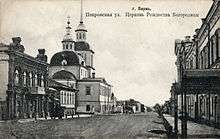
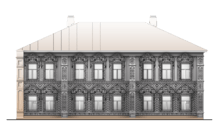
After the outbreak of the Russian Civil War, Perm became a prime target for both sides because of its military munitions factories. On December 25, 1918, the Siberian White Army under Anatoly Pepelyayev (who acknowledged the authority of the Omsk Government of Aleksandr Kolchak), took Perm. On July 1, 1919, the city was retaken by the Red Army.
- Some early color photographs by Sergey Prokudin-Gorsky, taken in 1910
.jpg) General view of City of Perm
General view of City of Perm.jpg) General view of the city of Perm from Gorodskiye Gorki
General view of the city of Perm from Gorodskiye Gorki.jpg) Razgulyay, outskirts of the city of Perm
Razgulyay, outskirts of the city of Perm Mary Magdalene Church of the city Perm
Mary Magdalene Church of the city Perm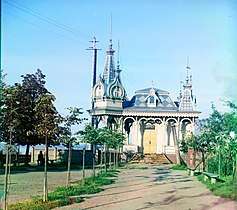 Summertime location of the exchange in the city Perm
Summertime location of the exchange in the city Perm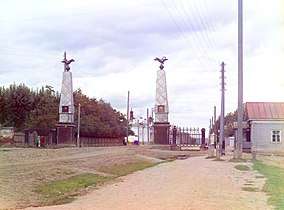 Prokudin-Gorsky — Staro-Sibirskaya Gate in the city of Perm
Prokudin-Gorsky — Staro-Sibirskaya Gate in the city of Perm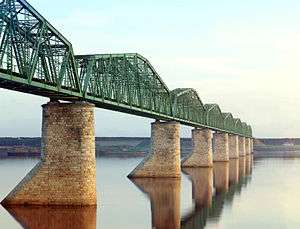 Kama River near Perm. The bridge still stands today, but another similar bridge has been built alongside it. Both are painted white.
Kama River near Perm. The bridge still stands today, but another similar bridge has been built alongside it. Both are painted white.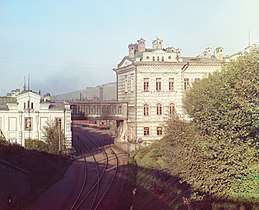 Headquarters of the Ural Railway Administration in the city of Perm
Headquarters of the Ural Railway Administration in the city of Perm
Soviet period
In the 1930s, Perm grew as a major industrial city with aviation, shipbuilding, and chemical factories built during that period. During the Great Patriotic War (World War II), Perm was a vital center of artillery production in the Soviet Union. During the Cold War, Perm became a closed city.[17]
Modern city

The city is a major administrative, industrial, scientific, and cultural centre. The leading industries include machinery, defence, oil production (about 3% of Russian output), oil refining, chemical and petrochemical, timber and wood processing and the food industry.
Since 2004, the first Muslim Cossack unit in post-Soviet Russia has been based in the city of Perm.
Administrative and municipal status
Perm is the administrative centre of the krai and, within the framework of administrative divisions, it also serves as the administrative center of Permsky District, even though it is not a part of it.[1] As an administrative division, it is, together with two rural localities, incorporated separately as the city of krai significance of Perm—an administrative unit with the status equal to that of the districts.[1] As a municipal division, the city of krai significance of Perm is incorporated as Perm Urban Okrug.[8]
City divisions
.svg.png)
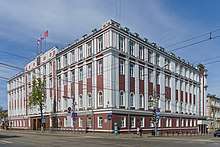
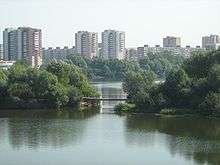
For administrative purposes, Perm is divided into seven city districts:
| City District | Population (2010 Census)[6] |
|---|---|
| Dzerzhinsky | 155,632 |
| Industrialny | 157,575 |
| Kirovsky | 127,793 |
| Leninsky | 48,520 |
| Motovilikhinsky | 179,961 |
| Ordzhonikidzevsky | 111,204 |
| Sverdlovsky | 210,477 |
Economy
Perm has the largest industrial output among cities in the Urals, ahead of Yekaterinburg, Chelyabinsk and Ufa, although Perm has a smaller population than these. Thirty-five per cent of Perm Oblast's industry is located in Perm.[18] The largest industries in the city are electric power engineering, oil and gas refining, machine building, chemicals and petrochemicals, forestry processing, printing and food industry.[19]
Several major industrial companies are located in Perm: AviraKids, a holding company, that produces 37.5% of Russian gaming equipment; Perm Motors and Aviadvigatel, major suppliers of engines to the Russian aircraft industry; rocket engine company Proton-PM, which will mass-produce the RD-191 engine for the upcoming Angara rocket family; electric engineering firms Morion JSC, Perm Scientific and Industrial Group, and Perm Electrical Engineering Plant; Russia's largest exporter of cables and wires, JSC KAMKABEL; and oil and natural gas companies such as LUKoil-Perm Ltd. and LUKoilPernefteprodukt Ltd.[18]
Transportation
Perm is an important railway junction on the Trans-Siberian Railway with lines radiating to Central Russia, the north part of the Urals, and the far east of Russia. Perm has two major railway stations, the historical Perm-I and the modern Perm-II. The Kama River is an important direct link between the European part of Russia to the sea ports on the White, Baltic, Azov, Black, and Caspian seas.[20]
Perm is served by the international airport Bolshoye Savino, 16 km (9.9 mi) southwest.
Perm's public transit network includes tram, bus, and city-railway routes. The formerly important trolleybus service has been discontinued in July 2019.
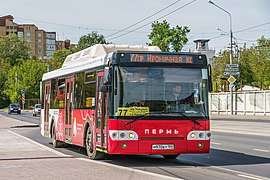 LiAZ-5292 (CNG motor version) city bus
LiAZ-5292 (CNG motor version) city bus Trolza-5265 low-floor trolleybus
Trolza-5265 low-floor trolleybus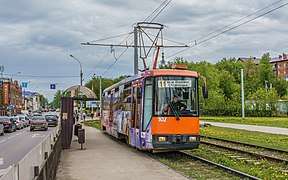 AKSM-60102 tram
AKSM-60102 tram Perm-II railway station
Perm-II railway station
Proposed metro system
The Perm Metro is a planned construction of a metro system which has been considered. The first plans date back to the 1970s. A feasibility study was compiled in 1990 but economic difficulties during the decade prevented its final planning and construction. The plans were revitalised in the early 2000s, but a lack of funding hampered the project and plans were once again put on hold. Light rail has also been considered.[21]
Culture
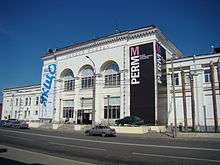
The Perm Opera and Ballet House is one of the best in Russia.[22] There are many other theatres in Perm, including the Drama Theater, the Puppet Theatre, the Theatre for Young Spectators, the Theatre "Stage Molot", and the Theatre "Near the Bridge".
Among the cities museums and galleries, the Perm State Art Gallery is recognised for its outstanding collections of art, including paintings from 15th- to 18th-century art movements, and wooden sculptures from the region. It is housed in a notable early 19th-century structure, once an orthodox cathedral. The spire of the museum towers over the rest of Perm, as it is situated on the Komsomolsky Prospect.[23] Perm is receiving attention from the development of the new Museum of Contemporary Art, Perm Museum of Contemporary Art (PERMM) which officially opened in March 2009.[24][25]
The RAV Vast steel tongue drum was invented in Perm by Andrey Remyannikov. This instrument is unique in the tongue drum and handpan world because each note has multiple harmonic overtones that resonate with other notes in the drum. The sound consequently has long sustain and reverberation.[26][27]
The Legend of Perm Bear or The Walking Bear is a sculpture depicting a walking bear, which is also shown on the city's coat of arms. It is situated in the central part of the city on Lenin Street, in front of the Organ Concert Hall and close to the building of Legislative Assembly of Perm Krai. The author of the sculpture is Vladimir Pavlenko, a monumentalist sculptor from Nizhny Tagil, member of the Artists' Union of Russia and UNESCO International Association of Arts.[28][29]
Perm is also home to the At the Bridge Theatre, the first mystical theatre in the world.
Education
Perm is a scientific centre; some of the scientific institutes are combined in the Perm Scientific Center of the Ural Branch of the Russian Academy of Sciences.
Perm is a home to several major universities including Perm State University,[30] Perm State Technical University,[31] Perm branch of state university Higher school of economics,[32] Perm State Teachers' Training University, Perm State Medical Academy,[33] Perm State Pharmaceutical Academy,[34] Perm State Agricultural Academy,[35] The Institute of Art and Culture, Perm State Choreographic School,[36] and others. There are also three military schools in Perm.
Climate
Perm has a warm summer continental climate (Köppen: Dfb).[37] Winters are long, snowy and quite cold. Summers are moderately warm with cool nights, although summers are shorter than winters.
| Climate data for Perm | |||||||||||||
|---|---|---|---|---|---|---|---|---|---|---|---|---|---|
| Month | Jan | Feb | Mar | Apr | May | Jun | Jul | Aug | Sep | Oct | Nov | Dec | Year |
| Record high °C (°F) | 4.3 (39.7) |
6.0 (42.8) |
15.0 (59.0) |
27.3 (81.1) |
34.6 (94.3) |
35.4 (95.7) |
36.6 (97.9) |
37.2 (99.0) |
30.7 (87.3) |
22.5 (72.5) |
11.9 (53.4) |
4.5 (40.1) |
37.2 (99.0) |
| Average high °C (°F) | −9.3 (15.3) |
−7.6 (18.3) |
0.1 (32.2) |
8.7 (47.7) |
16.9 (62.4) |
22.5 (72.5) |
24.2 (75.6) |
20.5 (68.9) |
13.9 (57.0) |
5.9 (42.6) |
−3.1 (26.4) |
−8 (18) |
7.1 (44.7) |
| Daily mean °C (°F) | −12.8 (9.0) |
−11.6 (11.1) |
−4.2 (24.4) |
3.5 (38.3) |
10.8 (51.4) |
16.5 (61.7) |
18.6 (65.5) |
15.3 (59.5) |
9.6 (49.3) |
3.0 (37.4) |
−5.8 (21.6) |
−11.1 (12.0) |
2.7 (36.9) |
| Average low °C (°F) | −16.2 (2.8) |
−15.1 (4.8) |
−8.1 (17.4) |
−0.9 (30.4) |
5.4 (41.7) |
11.1 (52.0) |
13.3 (55.9) |
11.0 (51.8) |
6.2 (43.2) |
0.5 (32.9) |
−8.4 (16.9) |
−14.2 (6.4) |
−1.3 (29.7) |
| Record low °C (°F) | −44.9 (−48.8) |
−40.8 (−41.4) |
−34.8 (−30.6) |
−23.5 (−10.3) |
−13 (9) |
−3.4 (25.9) |
1.7 (35.1) |
−1.9 (28.6) |
−7.8 (18.0) |
−25.2 (−13.4) |
−38.5 (−37.3) |
−47.1 (−52.8) |
−47.1 (−52.8) |
| Average precipitation mm (inches) | 44 (1.7) |
30 (1.2) |
28 (1.1) |
36 (1.4) |
59 (2.3) |
81 (3.2) |
70 (2.8) |
76 (3.0) |
72 (2.8) |
61 (2.4) |
55 (2.2) |
45 (1.8) |
657 (25.9) |
| Average rainy days | 1 | 2 | 4 | 11 | 18 | 18 | 17 | 20 | 21 | 17 | 7 | 3 | 139 |
| Average snowy days | 28 | 24 | 19 | 9 | 4 | 0.4 | 0 | 0 | 2 | 13 | 24 | 27 | 150 |
| Average relative humidity (%) | 83 | 79 | 72 | 65 | 62 | 68 | 71 | 77 | 80 | 82 | 85 | 85 | 76 |
| Mean monthly sunshine hours | 38 | 79 | 152 | 198 | 275 | 290 | 284 | 226 | 132 | 65 | 37 | 23 | 1,799 |
| Source 1: Pogoda.ru.net[38] | |||||||||||||
| Source 2: NOAA (sun, 1961–1990)[39] | |||||||||||||
Sports
The city hosted 2002 European Amateur Boxing Championships.
| Club | Sport | Founded | Current League | League Rank | Stadium |
|---|---|---|---|---|---|
| Zvezda 2005 Perm | Football | 1994 | Women's Supreme League | 1st | Zvezda Stadium |
| Oktan Perm | Football | 1958 | Russian Second Division | 3rd | Neftyanik Stadium |
| Molot-Prikamye Perm | Ice Hockey | 1948 | Higher Hockey League | 2nd | Universal Sports Palace Molot |
| Prikamye Perm | Volleyball | 1983 | Volleyball Super League | 1st | Sukharev Sports Complex |
| Permskie Medvedi | Handball | 1999 | Handball Super League | 1st | Permskie Medvedi Sports Complex |
| Parma Basket | Basketball | 2012 | VTB United League | 1st | Universal Sports Palace Molot |
Notable people
The following people were either born in Perm or made names for themselves while residing there.
- Dmitry Rybolovlev, businessman
- Zaki Ansari, Writer, Poet. born in Rajasthan India
- Michael Beilin (born 1976), Israeli Olympic Greco-Roman wrestler
- Tatiana Borodina, opera soprano
- Sergei Diaghilev, ballet impresario
- Alexandra Kosteniuk, 2008 Women's World Chess Champion
- Dmitry Mamin-Sibiryak, writer
- Tanya Mityushina, model
- Nikolay Moiseyev, astronomer
- Andronic Nikolsky (Andronik), first Bishop of Kyoto, Japan
- Fyodor Petrov, Soviet artillery designer
- Vladimir Chagin, Russian rally raid driver. the most successful single pilot in history of Dakar Rally
- Natasha Poly, supermodel
- Mikhail Osorgin philosopher
- Alexander Stepanovich Popov, physicist; widely regarded in Russia as the inventor of radio
- Mikhail Shuisky, opera singer
- Arkadiy Shvetsov, aircraft engine designer
- Nikolay Slavyanov, inventor of an early method of arc welding
- Peter Berngardovich Struve, political economist, philosopher, and editor
- Maxim Trankov, pairs figure skater
- Yuri Trutnev, Presidential Envoy to the Far Eastern Federal District
- Andrey Voronikhin, architect and painter
- Konstantin Zyryanov, association football player
- Katerina Shpitsa, actress of theater and cinema
- Alexei Ivanov, writer
- Tatiana Totmianina, pair skater, 2006 Olympic Champion
The Nobel-prize-winning writer Boris Pasternak lived in Perm for a time, and it figures in his novel Doctor Zhivago under the fictional name "Yuriatin" where Yuri sees Lara again in the public library.[41]
Marketing
Perm is an example of city marketing in Russia, with the city also having a logo.[42]
Twin towns – sister cities
Perm is twinned with:[43]
References
Notes
- Law #416-67
- (in Russian)Пермская Городская Дума
- Official website of the Head of Perm (in Russian)
- "Áàçà äàííûõ ïîêàçàòåëåé ìóíèöèïàëüíûõ îáðàçîâàíèé". gks.ru.
- http://perm-map.ru/map833552_0_1.htm.
- Russian Federal State Statistics Service (2011). "Всероссийская перепись населения 2010 года. Том 1" [2010 All-Russian Population Census, vol. 1]. Всероссийская перепись населения 2010 года [2010 All-Russia Population Census] (in Russian). Federal State Statistics Service.
- "26. Численность постоянного населения Российской Федерации по муниципальным образованиям на 1 января 2018 года". Federal State Statistics Service. Retrieved January 23, 2019.
- Law #2038-446
- Law #1868-402
- "Об исчислении времени". Официальный интернет-портал правовой информации (in Russian). June 3, 2011. Retrieved January 19, 2019.
- Почта России. Информационно-вычислительный центр ОАСУ РПО. (Russian Post). Поиск объектов почтовой связи (Postal Objects Search) (in Russian)
- Russian Federation - International Codes - The Phone Book from BT Archived April 13, 2014, at the Wayback Machine, Retrieved 2014-04-12
- Gramota.ru. #18475
- Russian Federal State Statistics Service (May 21, 2004). "Численность населения России, субъектов Российской Федерации в составе федеральных округов, районов, городских поселений, сельских населённых пунктов – районных центров и сельских населённых пунктов с населением 3 тысячи и более человек" [Population of Russia, Its Federal Districts, Federal Subjects, Districts, Urban Localities, Rural Localities—Administrative Centers, and Rural Localities with Population of Over 3,000] (XLS). Всероссийская перепись населения 2002 года [All-Russia Population Census of 2002] (in Russian).
- "Всесоюзная перепись населения 1989 г. Численность наличного населения союзных и автономных республик, автономных областей и округов, краёв, областей, районов, городских поселений и сёл-райцентров" [All Union Population Census of 1989: Present Population of Union and Autonomous Republics, Autonomous Oblasts and Okrugs, Krais, Oblasts, Districts, Urban Settlements, and Villages Serving as District Administrative Centers]. Всесоюзная перепись населения 1989 года [All-Union Population Census of 1989] (in Russian). Институт демографии Национального исследовательского университета: Высшая школа экономики [Institute of Demography at the National Research University: Higher School of Economics]. 1989 – via Demoscope Weekly.
- Official website of Perm. History.
- Jones, Finn-Olaf (July 22, 2011). "A Bilbao on Siberia's Edge?". The New York Times. Retrieved January 14, 2015.
- Industry Archived July 21, 2011, at the Wayback Machine Perm City Administration
- English version Archived May 22, 2011, at the Wayback Machine City of Perm. Department of Industrial Policy, Investment and Entrepreneurship
- Transport infrastructure — Perm regional server.
- "Archived copy". Archived from the original on May 7, 2011. Retrieved December 26, 2013.CS1 maint: archived copy as title (link) Perm' Metro Project; article (includes map); Urban Rail online; accessed .
- "Барыкина Л. Пермяки высадились на Манхэттене//Ведомости от 25.01.2008". Vedomosti.ru. January 25, 2008. Retrieved April 23, 2013.
- "Archived copy". Archived from the original on June 26, 2009. Retrieved June 12, 2009.CS1 maint: archived copy as title (link)
- "Perm Museums' Plan Dubbed the 'New Bilbao'". The Moscow Times. Archived from the original on August 4, 2012. Retrieved June 12, 2009.
- Kishkovsky, Sophia (May 28, 2009). "Modern Dance and Art Bring a Burst of Color to a Gray City". The New York Times. Retrieved May 22, 2010.
- RAV Vast - Steel Tongue Drum (November 24, 2016), Creation of RAV Drum, retrieved April 24, 2018
- "RAV Vast drum. Easy and enjoyable tongue drum". ravvast.com. Retrieved April 24, 2018.
- (in Russian) В центре Перми появился бурый медведь Archived December 5, 2007, at the Wayback Machine — РИА «Новый Регион».
- (in Russian) На пермских улицах появился медведь. Archived 2007-07-06 at Archive.today
- "Perm State University". Psu.ru. Archived from the original on November 25, 2012. Retrieved April 23, 2013.
- "Заставка - Пермский государственный технический университет". Pstu.ru. Retrieved April 23, 2013.
- "Государственный университет - Высшая школа экономики". Hse.perm.ru. Retrieved April 23, 2013.
- Perm State Academy Of Medicine Archived October 26, 2008, at the Wayback Machine
- http://www.psfa.ru/english/%5B%5D
- "Perm State Agricultural Academy". Pgsha.ru. Archived from the original on June 6, 2014. Retrieved April 23, 2013.
- Site developed by Perm RCI PSTU. "Perm State Ballet college". Balletschool.perm.ru. Retrieved April 23, 2013.
- "Perm, Russia Köppen Climate Classification (Weatherbase)". Weatherbase. Retrieved November 13, 2018.
- "Pogoda.ru.net" (in Russian). Weather and Climate (Погода и климат). Retrieved December 8, 2015.
- "Perm Climate Normals 1961–1990". National Oceanic and Atmospheric Administration. Retrieved December 8, 2015.
- https://translate.google.com/translate?hl=en&sl=ru&tl=en&u=http%3A%2F%2Fwww.rusbandy.ru%2Fclub%2F445%2F&sandbox=1
- http://www.oxfordperm-assoc.org/members-only/news-Jun06.pdf
- Artemy Lebedev thought up a logo of the Perm city (rus)
- "Города – побратимы Перми". v-perm.ru (in Russian). Perm. Retrieved February 1, 2020.
Sources
- Законодательное собрание Пермской области. Закон №416-67 от 28 февраля 1996 г. «Об административно-территориальном устройстве Пермского края», в ред. Закона №504-ПК от 9 июля 2015 г. «О внесении изменений в Закон Пермской области "Об административно-территориальном устройстве Пермского края"». Вступил в силу с момента опубликования. Опубликован: "Звезда", №38, 12 марта 1996 г. (Legislative Assembly of Perm Oblast. Law #416-67 of February 28, 1996 On the Administrative-Territorial Structure of Perm Krai, as amended by the Law #504-PK of July 9, 2015 On Amending the Law of Perm Oblast "On the Administrative-Territorial Structure of Perm Krai". Effective as of the moment of publication.).
- Законодательное собрание Пермской области. Закон №2038-446 от 11 февраля 2005 г. «Об утверждении границ и о наделении статусом муниципального образования "Город Пермь" Пермского края», в ред. Закона №499-ПК от 16 октября 2009 г «О внесении изменений в отдельные законодательные акты Пермской области и Коми-Пермяцкого автономного округа». Вступил в силу через десять дней со дня официального опубликования (12 марта 2005 г.), за исключением отдельных положений, вступивших в силу в иные сроки. Опубликован: "Российская газета", №41, 2 марта 2005 г. (Legislative Assembly of Perm Oblast. Law #2038-446 of February 11, 2005 On Establishing the Borders and on Granting the Status to the Municipal Formation of the "City of Perm" of Perm Krai, as amended by the Law #499-PK of October 16, 2009 On Amending Various Legislative Acts of Perm Oblast and Komi-Permyak Autonomous Okrug. Effective as of the day which is ten days following the day of the official publication (March 12, 2005), with the exception of certain clauses, which took effect on different dates.).
- Законодательное собрание Пермской области. Закон №1868-402 от 1 декабря 2004 г. «Об утверждении границ и о наделении статусом муниципальных образований Пермского района Пермского края», в ред. Закона №273-ПК от 14 декабря 2013 г. «О внесении изменений в отдельные Законы Пермской области, Коми-Пермяцкого автономного округа, Пермского края». Вступил в силу через десять дней со дня официального опубликования. Опубликован: "Бюллетень Законодательного Собрания и администрации Пермской области", №1, II часть, 27 января 2005 г. (Legislative Assembly of Perm Oblast. Law #1868-402 of December 1, 2004 On Establishing the Borders and on Granting the Status to the Municipal Formations of Permsky District of Perm Krai, as amended by the Law #273-PK of December 14, 2013 On Amending Various Laws of Perm Oblast, Komi-Permyak Autonomous Okrug, Perm Krai. Effective as of the day which is ten days following the day of the official publication.).
External links
- Official website of Perm (in Russian)
- Official website of the Perm City Duma (in Russian)
- Street View of Perm
- Perm Chamber of Commerce and Industry
- The Western Ural Photographic Album
- Virtual museum of Romanov in Perm
- History of Perm
- The city of Perm - The poem of the town
- Article about Perm Ballet
- S. Kishkovsky "Modern Dance and Art Bring a Burst of Color to a Gray City"
- Unofficial website of Perm
